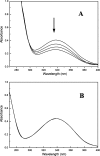Genetic characterization of the resorcinol catabolic pathway in Corynebacterium glutamicum
- PMID: 16963551
- PMCID: PMC1636210
- DOI: 10.1128/AEM.01494-06
Genetic characterization of the resorcinol catabolic pathway in Corynebacterium glutamicum
Abstract
Corynebacterium glutamicum grew on resorcinol as a sole source of carbon and energy. By genome-wide data mining, two gene clusters, designated NCgl1110-NCgl1113 and NCgl2950-NCgl2953, were proposed to encode putative proteins involved in resorcinol catabolism. Deletion of the NCgl2950-NCgl2953 gene cluster did not result in any observable phenotype changes. Disruption and complementation of each gene at NCgl1110-NCgl1113, NCgl2951, and NCgl2952 indicated that these genes were involved in resorcinol degradation. Expression of NCgl1112, NCgl1113, and NCgl2951 in Escherichia coli revealed that NCgl1113 and NCgl2951 both coded for hydroxyquinol 1,2-dioxygenases and NCgl1112 coded for maleylacetate reductases. NCgl1111 encoded a putative monooxygenase, but this putative hydroxylase was very different from previously functionally identified hydroxylases. Cloning and expression of NCgl1111 in E. coli revealed that NCgl1111 encoded a resorcinol hydroxylase that needs NADPH as a cofactor. E. coli cells containing Ncgl1111 and Ncgl1113 sequentially converted resorcinol into maleylacetate. NCgl1110 and NCgl2950 both encoded putative TetR family repressors, but only NCgl1110 was transcribed and functional. NCgl2953 encoded a putative transporter, but disruption of this gene did not affect resorcinol degradation by C. glutamicum. The function of NCgl2953 remains unclear.
Figures



Similar articles
-
Functional identification of novel genes involved in the glutathione-independent gentisate pathway in Corynebacterium glutamicum.Appl Environ Microbiol. 2005 Jul;71(7):3442-52. doi: 10.1128/AEM.71.7.3442-3452.2005. Appl Environ Microbiol. 2005. PMID: 16000747 Free PMC article.
-
The TetR-type transcriptional repressor RolR from Corynebacterium glutamicum regulates resorcinol catabolism by binding to a unique operator, rolO.Appl Environ Microbiol. 2012 Sep;78(17):6009-16. doi: 10.1128/AEM.01304-12. Epub 2012 Jun 15. Appl Environ Microbiol. 2012. PMID: 22706057 Free PMC article.
-
The ncgl1108 (PheP (Cg)) gene encodes a new L-Phe transporter in Corynebacterium glutamicum.Appl Microbiol Biotechnol. 2011 Jun;90(6):2005-13. doi: 10.1007/s00253-011-3245-z. Epub 2011 Apr 6. Appl Microbiol Biotechnol. 2011. PMID: 21468701
-
Transcriptional regulation of catabolic pathways for aromatic compounds in Corynebacterium glutamicum.Genet Mol Res. 2006 Dec 7;5(4):773-89. Genet Mol Res. 2006. PMID: 17183485 Review.
-
Cell growth and cell division in the rod-shaped actinomycete Corynebacterium glutamicum.Antonie Van Leeuwenhoek. 2008 Jun;94(1):99-109. doi: 10.1007/s10482-008-9224-4. Epub 2008 Feb 19. Antonie Van Leeuwenhoek. 2008. PMID: 18283557 Review.
Cited by
-
Crystal structures of the transcriptional repressor RolR reveals a novel recognition mechanism between inducer and regulator.PLoS One. 2011 May 3;6(5):e19529. doi: 10.1371/journal.pone.0019529. PLoS One. 2011. PMID: 21559286 Free PMC article.
-
Characterization of a gene cluster involved in 4-chlorocatechol degradation by Pseudomonas reinekei MT1.J Bacteriol. 2009 Aug;191(15):4905-15. doi: 10.1128/JB.00331-09. Epub 2009 May 22. J Bacteriol. 2009. PMID: 19465655 Free PMC article.
-
Physiological Response of Corynebacterium glutamicum to Indole.Microorganisms. 2020 Dec 8;8(12):1945. doi: 10.3390/microorganisms8121945. Microorganisms. 2020. PMID: 33302489 Free PMC article.
-
Characterization of a Unique Pathway for 4-Cresol Catabolism Initiated by Phosphorylation in Corynebacterium glutamicum.J Biol Chem. 2016 Mar 18;291(12):6583-94. doi: 10.1074/jbc.M115.695320. Epub 2016 Jan 27. J Biol Chem. 2016. PMID: 26817843 Free PMC article.
-
Phenylacetic acid catabolism and its transcriptional regulation in Corynebacterium glutamicum.Appl Environ Microbiol. 2012 Aug;78(16):5796-804. doi: 10.1128/AEM.01588-12. Epub 2012 Jun 8. Appl Environ Microbiol. 2012. PMID: 22685150 Free PMC article.
References
-
- Bradford, M. M. 1976. A rapid and sensitive method for the quantitation of microgram quantities of protein utilizing the principle of protein-dye binding. Anal. Biochem. 72:248-254. - PubMed
-
- Denef, V. J., J. A. Klappenbach, M. A. Patrauchan, C. Florizone, J. L. M. Rodrigues, T. V. Tsoi, W. Verstraete, L. D. Eltis, and J. M. Tiedje. 2006. Genetic and genomic insights into the role of benzoate-catabolic pathway redundancy in Burkholderia xenovorans LB400. Appl. Environ. Microbiol. 72:585-595. - PMC - PubMed
Publication types
MeSH terms
Substances
LinkOut - more resources
Full Text Sources
Other Literature Sources
Molecular Biology Databases

